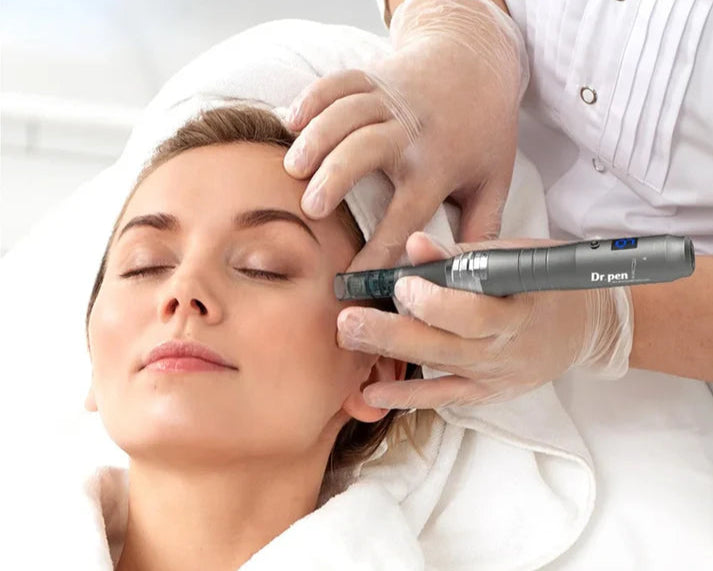Cellulite, often referred to as the "orange peel" or "cottage cheese" skin, is a common concern for many individuals, particularly women. It appears as dimpled, lumpy skin, predominantly on the thighs, hips, and buttocks. Despite being a natural occurrence due to the structure of fatty tissue under the skin, cellulite can significantly impact one's self-esteem and confidence. As a result, numerous treatments and remedies have emerged, claiming to reduce or eliminate cellulite. One such method gaining popularity is the use of a microneedling pen. But can this device truly help with cellulite? Let's delve into the details.

Understanding Cellulite
Before exploring the potential of a microneedling pen, it's essential to understand what cellulite is and why it forms. Cellulite occurs when fat deposits push through the connective tissue beneath the skin, causing the surface to appear uneven. Several factors contribute to the development of cellulite, including genetics, hormones, lifestyle, and age. While it's not a health risk, many people seek ways to minimize its appearance for cosmetic reasons.
What is a Microneedling Pen?
A microneedling pen is a handheld device equipped with tiny, fine needles that puncture the skin's surface. This process, known as microneedling or collagen induction therapy (CIT), aims to stimulate the skin's natural healing response. By creating micro-injuries, the body is prompted to produce more collagen and elastin, which are essential for skin firmness and elasticity.
Originally developed for treating scars, wrinkles, and hyperpigmentation, microneedling has since been explored for various other skin concerns, including cellulite. The idea is that by stimulating collagen production in the affected areas, the skin's texture and appearance may improve, potentially reducing the visibility of cellulite.
How Microneedling Might Help with Cellulite
The theoretical basis for using a microneedling pen to address cellulite revolves around its ability to enhance skin structure and texture. Here's how it might work:
Collagen and Elastin Production: As mentioned, microneedling triggers the production of collagen and elastin. Increased levels of these proteins can help firm up the skin, making it less prone to dimpling.
Improved Blood Flow: The micro-injuries caused by the needles can also enhance blood circulation in the treated area. Better blood flow means more nutrients and oxygen are delivered to the skin cells, promoting overall skin health.
Lymphatic Drainage: Microneedling may stimulate the lymphatic system, aiding in the removal of toxins and excess fluid from the tissues. This can contribute to a smoother skin appearance by reducing fluid retention and inflammation that can exacerbate cellulite.
Skin Thickening: Repeated microneedling sessions can lead to the thickening of the dermis, the layer of skin beneath the epidermis. A thicker dermis provides better support to the surface layer, potentially minimizing the appearance of cellulite.
The Procedure and Aftercare
Using a microneedling pen for cellulite typically involves a series of treatments spaced a few weeks apart. The procedure itself can be performed in a dermatologist's office or at home with a high-quality, FDA-approved device. Here's a general outline of what to expect:
Preparation: The area to be treated is thoroughly cleaned and may be numbed with a topical anesthetic to minimize discomfort.
Treatment: The microneedling pen is gently glided over the skin, creating tiny punctures. The process can take anywhere from 15 to 30 minutes, depending on the size of the area being treated.
Aftercare: Post-treatment, the skin may be red and slightly swollen, akin to a mild sunburn. It's crucial to keep the area hydrated and protected from the sun. Avoiding harsh skincare products and treatments for a few days is also recommended.
Potential Risks and Considerations
While microneedling is generally safe when performed correctly, it's not without risks. Some potential side effects include:
Infection: If the needles or the treated area are not properly sterilized, there's a risk of infection.
Scarring: In rare cases, microneedling can cause scarring, especially if the needles are used too aggressively or if the skin is not properly cared for afterward.
Pigmentation Changes: Some individuals may experience hyperpigmentation or hypopigmentation, where the skin becomes darker or lighter in the treated area.
It's essential to consult with a dermatologist or a trained professional before undergoing microneedling treatments, especially if you have any underlying health conditions or are taking medications that could affect skin healing.
Combining Microneedling with Other Treatments
For optimal results, microneedling is often combined with other cellulite-reducing treatments. For instance:
Topical Creams and Serums: Applying creams or serums containing ingredients like caffeine, retinol, or vitamin C can enhance the effects of microneedling by penetrating deeper into the skin.
Massage Therapies: Regular massage, particularly lymphatic drainage massage, can complement microneedling by further improving blood flow and lymphatic circulation.
Healthy Lifestyle: Maintaining a balanced diet, staying hydrated, and engaging in regular physical activity can also support the results achieved through microneedling.
Realistic Expectations
It's important to set realistic expectations when considering microneedling for cellulite. While it may improve the skin's texture and firmness, it's unlikely to completely eliminate cellulite. Cellulite is a complex issue influenced by multiple factors, and a multifaceted approach is often necessary for significant improvement.
Furthermore, individual responses to microneedling can vary. Some people may see noticeable results after a few sessions, while others may require more treatments to achieve their desired outcome. Patience and consistency are key when undergoing any skin-improving regimen.
Conclusion
In summary, a microneedling pen can be a valuable tool in the fight against cellulite. By stimulating collagen production, improving blood flow, enhancing lymphatic drainage, and thickening the skin, microneedling has the potential to reduce the visibility of cellulite and improve skin texture. However, it's not a magic bullet and should be part of a comprehensive approach to managing cellulite.
Before embarking on microneedling treatments, consult with a qualified professional to discuss your goals, assess your skin's suitability, and develop a personalized treatment plan. With realistic expectations and a commitment to aftercare, microneedling can be a safe and effective addition to your cellulite-reduction strategy.

Share:
How to Adjust the Speed of Your Microneedling Pen
How to Choose a Microneedling Pen for Professional Use